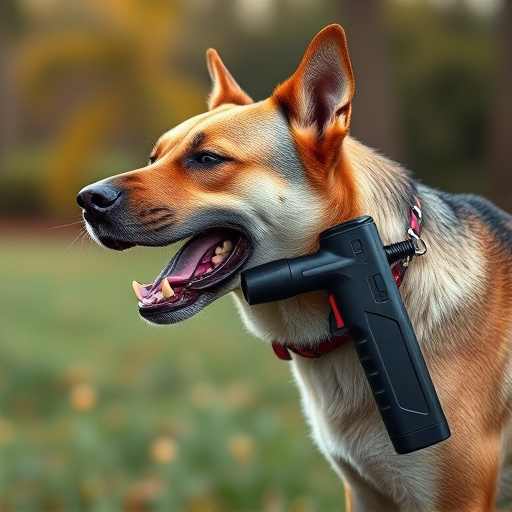Mail carriers and security personnel should be trained in using non-lethal pepper spray as a defense mechanism, focusing on safety and immediate water rinsing (15 minutes) for exposed animals. Dog spray, containing capsaicin, temporarily incapacitates dogs but causes respiratory distress and irritation. Prompt emergency care includes warm water cleaning, drying, and veterinary assistance to prevent long-term harm, with regular inspections and decontamination for preventive measures. Key term: Emergency Care for Maced Animals.
“Discovering the potential risks and remedies surrounding mail carrier dog spray mace is essential, especially considering the increasing instances of its use. This article provides a comprehensive guide on understanding this controversial tool, from its basic mechanics to its profound effects on animals. We explore emergency care protocols for exposed pets, delving into the science behind dog spray and its impact. Additionally, we offer post-exposure care tips and prevention strategies to ensure animal safety in such situations.”
- Understanding Mail Carrier Dog Spray Mace: A Brief Overview
- When and How to Use Emergency Care for Mace-Exposed Animals
- The Science Behind Dog Spray and Its Effects on Animals
- Post-Exposure Care and Prevention Strategies for Animals Treated with Dog Spray
Understanding Mail Carrier Dog Spray Mace: A Brief Overview
Mail carrier dog spray mace, also known as pepper spray or oleoresin capsicum (OC) spray, is a non-lethal self-defense tool designed to incapacitate an assailant temporarily. It works by irritating the eyes and respiratory system, causing tears, coughing, and difficulty breathing. This weapon is often carried by mail carriers, security personnel, and others who need to protect themselves in potentially dangerous situations.
Understanding how to use it properly and what to expect during and after exposure is crucial for both users and those who might encounter it. Emergency care for maced animals, for instance, involves immediate rinsing of the eyes with clean water for at least 15 minutes and seeking medical attention if symptoms persist. The overview highlights the importance of training and preparation, ensuring individuals know how to respond appropriately in an emergency involving this type of spray.
When and How to Use Emergency Care for Mace-Exposed Animals
If a mail carrier or any individual encounters an animal that has been exposed to mace spray, immediate action is crucial. The first step is to ensure the safety of both the animal and the person handling the situation. Emergency care for mace-exposed animals involves moving the animal to a safe, enclosed space, away from direct sunlight and potential hazards. This temporary shelter should be well-ventilated to prevent any buildup of toxic fumes.
The next step is to gently remove any contaminated clothing or fur, being mindful not to rub or scratch the skin, which could further irritate the animal. Rinsing the affected area with copious amounts of water for at least 15 minutes is essential to dilute and wash away the mace spray. Throughout this process, it’s important to monitor the animal’s vital signs, ensuring they remain stable. If symptoms persist or worsen, emergency veterinary care should be sought immediately, as proper Emergency Care for Maced Animals can significantly aid in alleviating discomfort and potential long-term effects.
The Science Behind Dog Spray and Its Effects on Animals
Dog spray, or mace, is a chemical agent designed to temporarily incapacitate or deter animals, primarily dogs. The active ingredients in dog spray are typically capsaicin, a compound found in chili peppers, or other irritants that cause a burning sensation when they come into contact with the animal’s eyes, nose, and mouth. When used responsibly, dog spray can serve as an effective tool for mail carriers and others who encounter aggressive dogs.
The effects of dog spray on animals are rapid and intense. It causes irritation to the respiratory tract, eyes, and skin, leading to temporary blindness, coughing, and difficulty breathing. These symptoms typically subside within minutes after exposure. However, it’s crucial to emphasize that emergency care for maced animals is essential. If a dog is exposed to dog spray, immediate washing of the affected areas with water and seeking veterinary assistance is recommended to prevent long-term damage and ensure the animal’s well-being.
Post-Exposure Care and Prevention Strategies for Animals Treated with Dog Spray
After an animal is exposed to dog spray, immediate post-exposure care becomes crucial. The first step is to remove any visible remnants of the spray from the animal’s fur and skin using warm water and a mild detergent. It’s essential to do this gently to avoid further irritation. After rinsing, thoroughly dry the affected area, ensuring no moisture remains as it can prolong discomfort.
Preventive measures are equally vital to ensure the well-being of animals. This includes keeping the treated animal away from areas where dog spray is commonly used or stored. Regularly inspecting and cleaning the animal’s fur and skin, especially after outdoor activities, can help detect any signs of irritation or allergic reactions early on. Additionally, consulting a veterinarian for appropriate decontaminants and monitoring the animal’s health post-exposure is recommended to provide emergency care for maced animals effectively.
Mail carrier dog spray, or mace, can pose significant risks to animals if not handled properly. Understanding its science, effects, and appropriate post-exposure care is crucial in ensuring effective Emergency Care for Mace-Exposed Animals. By knowing when and how to use emergency treatments, along with prevention strategies, we can mitigate the impact of dog spray on animals and foster safer interactions between mail carriers and pets.
